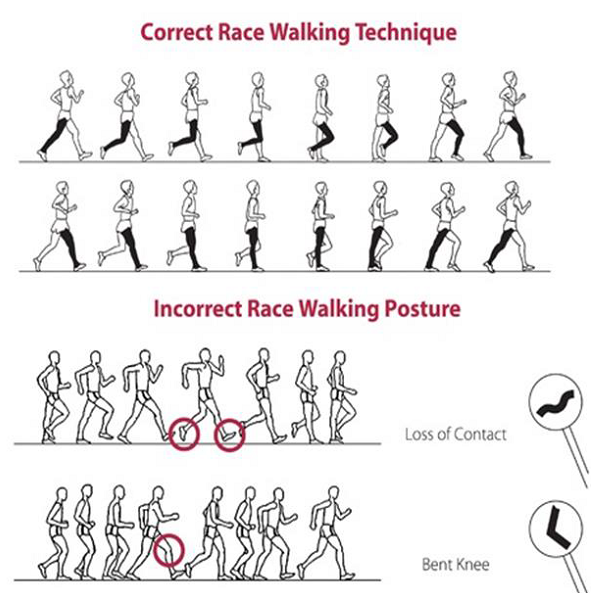How To Racewalk?
The Racewalking tournament typically kicks off by a gun fire, with the athletes in their positions just at the start line. The tournaments are held on 10km, 20 km and 50 km distances.
Getting Ready
The walking races begin when all the players assemble at the start line in a stadium. As the walkers cannot race in lanes so they take standing positions at the start line on the command “On your marks”. The starter of the tournament ensures no player to stand on the start line after the command.
A five minute, three minute and one minute warning signs are given to the athletes before beginning of the race, followed by a gun fire with an indication to all the participants to start the race.
Along with the athletes the judges play a very crucial role in Racewalking competitions. Six to nine judges are assigned for each tournament; along with a chief judge to constantly monitor the athlete’s walking technique throughout the tournament all along the road course until the player ends his race at the finish line. At any instance if an athlete gets 3 red cards from 3 different judges, the chief judge disqualifies the athlete from the race.

Quick Glimpse of the Game
Racewalking refers to a movement of feet of the walker when the walker progresses forward making constant contact with the ground, and no visible loss of contact occurs at any point of time for the judges. Ideally this walking technique is popularly known as “heel-to-toe” motion keeping the arm to shoulder motion low to ground.
The next important technique of Racewalking is the advancing of the leg without bending at the knee being visible to the human eye known as the “lifting or bent knee” rule. From the instant of losing one foot contact from the ground the other foot shall be straightened until the first foot is back on the ground with vertical upright position.
Throughout the Racewalking challenge, the two rules if violated by the athletes for three times and three different judges notice the violation of techniques, the walker is given red card and is disqualified from the competition.
The athlete who finishes the Racewalking competition without violation of the rules, walks through the specified distance. Unlike other athletic sport events, in Racewalking the walker’s needs to touch the finish line before the other competitors as to declare the winner of the tournament.
Rules of Racewalking
Racewalking is a very tough disciplinary sport being physically monitored by multiple judges, yet the walkers are increasingly participating in the walking road events and competitions. The rules are clearly defined by the IAAF (International Association of Athletics Federation) for the participants of this sport as listed below −
-
Loss of Contact Rule − During speed walking the walker’s feet should never loose contact with the ground as visible to the human eye. The heel of one foot should definitely touch the ground before the toe of the other foot leaves the ground. There will be a millisecond per stride where both the foot of the athlete loose contact with the ground, but are not in the range of visibility to the human eye and are undetectable.
-
The Bent Knee Rule − In the course of progressing the athlete’s steps forward, the advancing leg making contact with the ground should be straightened from the hip to the foot. Until the other foot reaches to the vertical upright position, the bending of the knee indicates a violation of this rule. At any point of time the knees should be visible to the judges.
-
Yellow Paddle − The judges can issue a yellow paddle to the walker as a caution when the walker is very close to breaking the above two rules. A walk judge can issue a yellow paddle for the same athlete only twice, once for loss of contact and once for bent knee.
-
Red Card − Out of the appointed judges of the event, if any one judge has an opinion that the athlete has violated any of the above two rules, at that instant the judge issues a silent red card for that particular walker and will send it to the chief judge. The athlete is unaware of the red card being issued to him. Every single judge can issue a red card to all the walkers but only once in the whole competition.
-
Disqualification of an Athlete − An athlete can only be disqualified from the walking competition by the chief judge. If the chief judge gets three such individual red cards from three different judges, he calls for that particular athlete’s disqualification from the competition. The yellow paddles issued to the walkers are not considered as criteria for disqualification. If the athlete still continues the race even after disqualification being called out and finishes first, he does not win the race.
